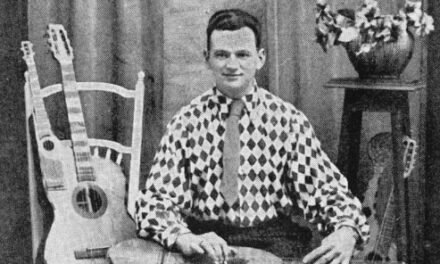Here’s an interesting one!
My friend Guy DeVillez sent me pics of this awhile back and I had to admit I’d never heard of the maker, F. W. Walton. It looked like a questionable homemade one-off, and at first glance I thought it might simply be a doubleneck guitar, as most of Guy’s friends did. Of course, the bridge was the dead giveaway – it would be kinda hard to intonate your second neck frets with that slant! So was it a mistake? Or was this just one of those occasional “fretted harp guitars”? Neither, it turned out – just a design choice.
Guy brought it over to show me over a year ago, kindly leaving it for me to photograph, as it was far more interesting than I had predicted. It came from the estate of his late friend R. C. Allen (who was subsequently profiled in Fretboard Journal #33), found in a forgotten trailer full of odds and ends. Incidentally, Guy is selling this (quite inexpensively) if anyone is interested.

Nothing is known about its provenance, nor have Guy or I found any info whatsoever on Walton. Did Walton make other instruments or cabinetry/furniture? Note his stamp burned into the center strip.
There was a Trenton, New Jersey full-service musical instrument company from 1896-on named C. H. Walton & Co. – any relation? One strange addition to the puzzle is this c.1900 mandolinetto below (from eBay some years ago) that has a very similar wood-burned stamp, but reads “H. A. Walton” as opposed to the harp guitar’s “F. W.” Yet, clearly they share the same background – the similar massive quantity, size and style of pearl inlays is unmistakable! Perhaps two brothers in the same shop? Or father and son? Note the stamps burned into the center strip of the two instruments.


For now I’m imagining Chicago for F. W., and around 1900 – when Walton might’ve come across one of Bohmann’s outrageously humongous “contrabass” harp guitars. It seems too coincidental that the body is such a close match to Bohmann’s unique body design. I didn’t realize how close until I happened to lay them down together side by side (“spooning,” as it were).

Walton made his with a flat back as opposed to Bohmann’s heavily domed one (heat-pressed over a giant iron mold). Bohmann’s is made from his typical 3-ply sandwich (maple between Brazilian rosewood), while the Walton looks like walnut.

Though Bohmann’s domed back adds a bit more volume (5-3/4″ Walton’s 5″) to , Walton’s top is slightly larger – owing to its wider waist. Top dimensions are 14″ wide upper bout, 12″ wide waist, 18-3/4″ lower bout and 24″ in length! He adds a larger soundhole a bit further down on the face of the X-braced top (you’ll see Bohmann’s bracing in a later chapter). Note how he locates the bridge further down to center on the body. He does this by having the neck meet at the 11th fret (as opposed to Bohmann’s 12th) and providing a staggering baritone-worthy scale length of 29-and-change inches! Bohmann’s is a normal 25”. It’s almost as if Walton was thinking – like me – Wait a minute! Why is Bohmann building a giant guitar, calling it a “contrabass,” then only giving it a standard scale length and pitch?!
Here, I’ve placed my Dyer behind the two just for a size reality check. Those suckers are huge!

Getting back to the bridge, check out Walton’s interesting individual dowel bone saddles for each string – something else Bohmann may have inspired with his many bridge inventions.


As you can see, Walton’s second neck “frets” are inlaid bone and were obviously intended to create a visual duplication of the playable neck, as were the intentional “symmetrical” matching fret markers. But what a piss-poor job! They’re just inexplicably thrown on, without remotely bothering with measurements or simple visual alignment. How odd to perform all that extra work without even laying it out!
His inlays also seem to be inspired by Bohmann’s own aesthetically dubious inlays.

He similarly does otherwise fine work, especially in the guitar’s wood fit and finish. I wonder if maybe F. Walton built the instrument and then let a hypothetical F. Walton, Jr. do the neck and head decoration…

For more on Walton’s instrument, why not restore it yourself and tell us what you learn? Just send Guy a note through FB here – he’d love to find it a good home!
Coming Soon: Bohmann’s incredible contrabass harp guitars!







I’ve decided to take it on, Gregg. It should arrive on my doorstep next week sometime. I’ll post photos of the renovation for the entertainment of the good folks here in the Forum when I get underway. Thanks for letting me know about it!
Fantastic article Gregg. Fascinating! I await chapter 2 with delightful anticipation. What a wonderful instrument. How does it sound? Must be fairly loud. All the best and keep up the great work.
Hmmm. A blind, slotted peghead. Why would that be a good idea I wonder?